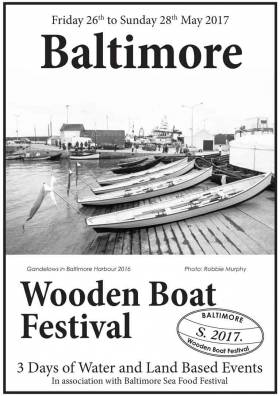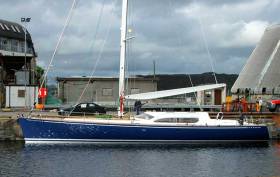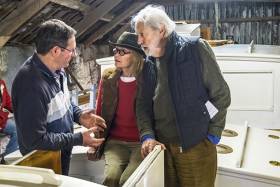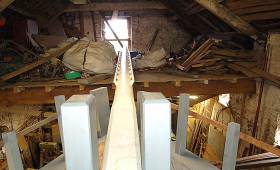Displaying items by tag: Ilen
The annual Baltimore Wooden boat Festival this weekend (full dates are Friday 26th to Sunday 28th May) provides the perfect setting for a remarkable range of craft of all shapes, sizes and rigs writes W M Nixon. It brings with it all sorts of celebrations and activities afloat and ashore to match an occasionally – indeed, frequently – eccentric gathering of traditional and wooden boat fans.
Scroll down this story to read the full programme below.
In fact, there’s noting quite like it on sea or land anywhere in Ireland, as it’s a heady mixture of craft of types sometimes half as ancient as time itself, testing themselves afloat and against each other, with all of it including the inter-boat banter which is so much part of the sport.
Best of all, the meteorological portents are good - it looks as though it is going to happen in what might well be a weekend of better than reasonably good summer weather, so we can expect the hospitable sea-minded West Cork port to be totally en fete afloat and ashore.
They’ll be coming from all over Ireland and beyond, and a significant presence will be the Ilen Boat Building School from Limerick. Not only is their 57ft ketch Ilen nearing restoration near Baltimore at Oldcourt, but they will be bringing a collection of craft built by trainees in the school, where they also built the deckhouses and spars for the Ilen.
A focus of close attention will be one of the smallest boats of all, the 10ft Valentine Punt, which is assembled from a laser-cut kit based on marine plywood. The basic design used is a 10ft dinghy built in the 1920s in Passage West on Cork Harbour for John Valentine Sisk, and it his grandson, maritime historian Hal Sisk, who vividly remembers what a special pleasure it was to row this elegant yet practical little boat.
 The new Valentine Punt built by Elan Broadley in the Ilen Boatbuilding School in Limerick is remarkable for its lightness. Photo Gary MacMahon
The new Valentine Punt built by Elan Broadley in the Ilen Boatbuilding School in Limerick is remarkable for its lightness. Photo Gary MacMahon
Thus he got the idea of making building kits available, using edge-glued (with epoxy) plywood “planks” to emulate the original’s traditional clinker construction, thereby providing a boat which is lighter yet more durable with much less maintenance.
When Hal heard the Ilen people were looking for a dinghy to act as tender for their vessel, he donated one of the kits to the school. And this newest Valentine Punt, which will debut in Baltimore at the weekend, has been built in the Limerick school by Elan Broadley from Donegal.
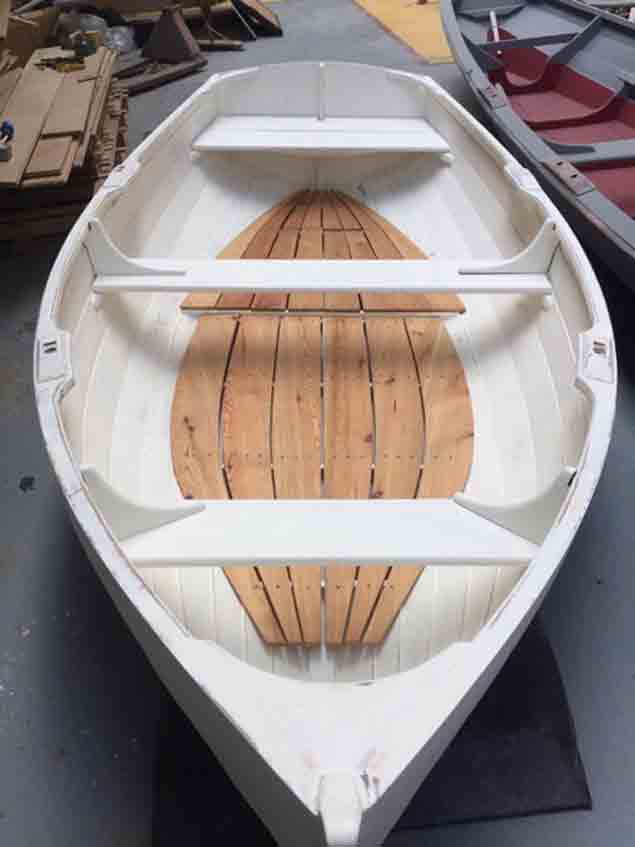 With edge-glued “clinker” construction, the new Valentine Punt is easily maintained – unlike a traditional clinker boat as the bilges can be cleaned in seconds. Photo: Gary MacMahon
With edge-glued “clinker” construction, the new Valentine Punt is easily maintained – unlike a traditional clinker boat as the bilges can be cleaned in seconds. Photo: Gary MacMahon
He had no experience of boatbuilding when he started, yet with patience he has learned as he worked, under instruction when needed. It may have taken 500 hours in all for him to complete the job, but the result is a lovely little boat. Among those there to celebrate with her proud builder at Baltimore this weekend will be his mother down from Donegal, and Hal Sisk, who learned to row in the original boat more than sixty years ago.
So in Baltimore this weekend, the mood in the sunshine will be of nostalgia and anticipation. Soon, the Ilen will launch. And once she is in full commission, the focus will turn to building a re-creation of Conor O’Brien’s famous world-girdling 40ft ketch Saoirse, originally built in Baltimore 95 years ago. Her re-birth comfortably in advance of her Centenary in 2022 is a very worthy target.
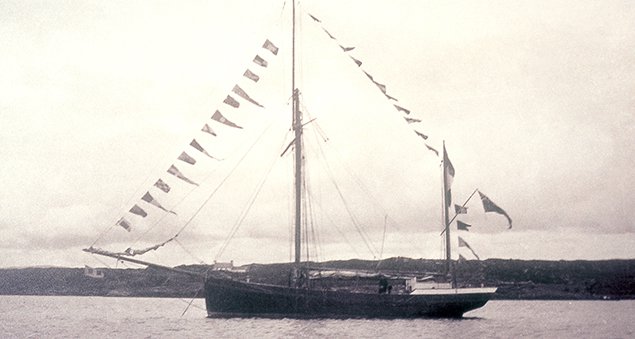 Ilen on her first commissioning day at Baltimore in 1927
Ilen on her first commissioning day at Baltimore in 1927
The Baltimore Wooden Boat Festival 2017 from Friday 26th to Sunday 28th May will feature a remarkable selection of old, restored and new craft - traditional and classic alike - all reflecting the many aspects of the arts and crafts of the boatwright and shipwright writes W M Nixon.
The hospitable setting is highly appropriate, as there are more skilled boatbuilders beavering away in hidden workshops in West Cork than in any other comparable part of Ireland. And a few miles upriver from Baltimore on the River Ilen (which in due course brings you to the Olympic Medal-winning Skibbereen Rowing Club), you’ll find the boatyards of Oldcourt, where among other projects, Liam Hegarty and his craftsmen are bringing the restoration of the 1927-built ketch Ilen of Conor O’Brien fame to completion.
It’s the Ilen which provides a link to a notable debut at Baltimore by a new small boat in three weeks’ time. With both his world-girdling 40ft Saoirse of 1923, and the 57ft trading ketch Ilen which he delivered to her satisfied customers in the Falkland Islands, O’Brien felt that a robust and stable 10ft dinghy – or punt as he would have called it – provided all that he needed in the way of a ship’s tender.
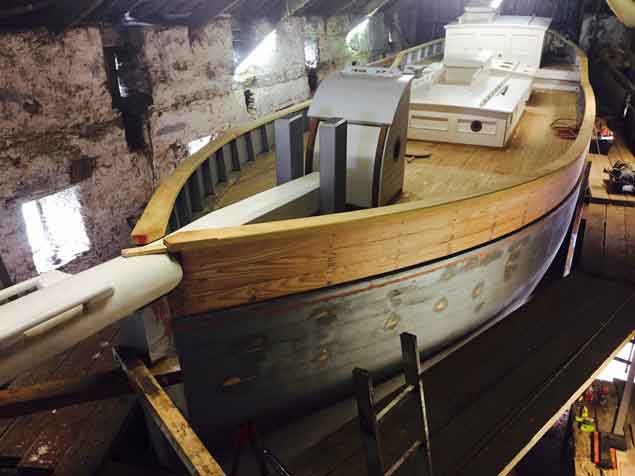 Progress continues on the restoration of Ilen. All the deckhouses - built in the Ilen Boatbuilding School in Limerick – have now been installed in the ship herself at Oldcourt near Baltimore. Photo Gary MacMahon
Progress continues on the restoration of Ilen. All the deckhouses - built in the Ilen Boatbuilding School in Limerick – have now been installed in the ship herself at Oldcourt near Baltimore. Photo Gary MacMahon
He wasn’t alone in this view. At the same time in 1926 on Cork Harbour, John Valentine Sisk, owner of the substantial motor-launch Culleann, ordered a new 10ft punt for use as Culleann’s tender from noted Passage West boatbuilder Pierce Power. Cullean already had a 10ft punt, but it was considered too unstable. So Pierce Power faced the considerable challenge of creating a boat only 10ft long with firm midships sections for stability, yet with bow and stern artfully shaped to retain her predecessor’s ease of rowing.
He succeeded brilliantly, so much so that the Sisk family kept the punt after Cullean had moved on. Before John Valentine Sisk’s death in 1957, his three grandsons George, Hal and John had learned to row in this very special little boat. Then with his son John G Sisk now moved to Dublin, the Valentine Punt followed to be the tender to his Dun Laoghaire-based yachts Marian Maid, Stern and Sarnia until 1970.
She then went to a son-in-law Schull, and eventually was bought by fishermen on Long Island, where her yacht-style varnish was painted over, and finally tarred. She was reckoned past her working days when Hal Sisk found this fondly-remembered boat of his childhood and youth on the island, and had her restored. In time, she became part of the collection in the National Maritime Museum in Dun Laoghaire as representative of a type once found at every yacht and fishing harbour on Ireland’s south coast, and many other ports and anchorages elsewhere.
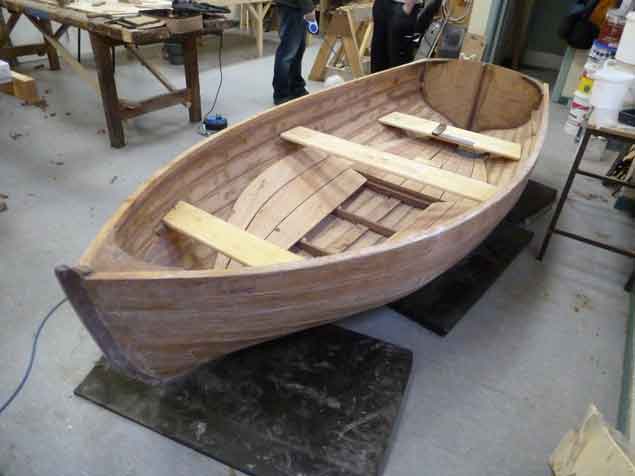 The Valentine Punt with the aft thwart removed to show the carefully-calculated shape of the transom – when afloat, it will offer minimum drag while helping when necessary with the hull form’s inherent stability.
The Valentine Punt with the aft thwart removed to show the carefully-calculated shape of the transom – when afloat, it will offer minimum drag while helping when necessary with the hull form’s inherent stability.
However, it was the ease of rowing the Valentine Punt which was the fondest memory, so the late Michael Tyrrell of Arklow took off her lines for Hal Sisk with a re-creation in mind. But it was reckoned that real benefit would be conferred if the lines could be used, yet instead of the inevitably heavy traditional clinker construction with ribs (timbers), much lighter construction could be achieved by building instead with glued clinker ply.
Alec Jordan in Scotland is an acknowledged expert in creating laser cut marine ply kits, which are then built into a boat with the “lands” of the lapstrake planks now bonded and sealed with impervious gap-filling epoxy resin. The result of this project was an elegant hyper-light and easily-rowed yet stable 10ft punt which has been the ideal tender for Hal Sisk’s classic cutter Peggy Bawn and his innovative motor-cruiser Molly Bawn.
The Valentine Punt is a concept which could have many uses, and when the notion of having one as the tender to the restored Ilen came up, the Ilen Boatbuilding School director Gary MacMahon in Limerick leapt at the chance, as the school is always enthusiastic about testing new methods of wooden boatbuilding to broaden its syllabus.
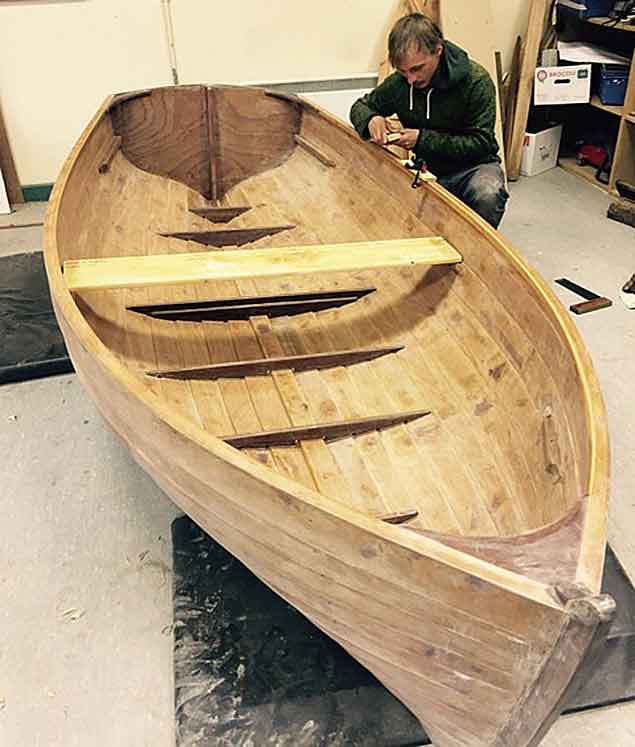 Elan Broadley at work on his special creation, the latest Valentine punt developed from a proven design which is now 91 years old. Photo: Gary MacMahon
Elan Broadley at work on his special creation, the latest Valentine punt developed from a proven design which is now 91 years old. Photo: Gary MacMahon
This latest model of the Valentine Punt has been built in the school by Elan Broadley, a trainee boatbuilder from Donegal, and he and his attractive creation will be making their debut in Baltimore during the Wooden Boat Festival, with a bit of a party involving all the main players, and his mum down from Donegal. After that, the little boat won’t have far to go to be united with her mother ship, the Ilen herself, preparing for launching at Oldcourt.
What Colour Ilen's Hull? - You Decide in Afloat Poll
The new Larch hull of the ketch Ilen nearing completion in West Cork has had its first coat of primer, only after much plugging, filling and sanding. Preparation, as all painters know, is the difference between a good job and a not so good one.
In a few weeks it will be time to follow the undercoat with a good finish or topcoat. And apart form the many paint types one has to choose from, comes the additional aesthetic choice - which hull colours might the good ship Ilen ultimately carry.
A wide hull colour selection process has been narrowed down to two distinct options - Green and Grey. Let us know what you think in the poll below:
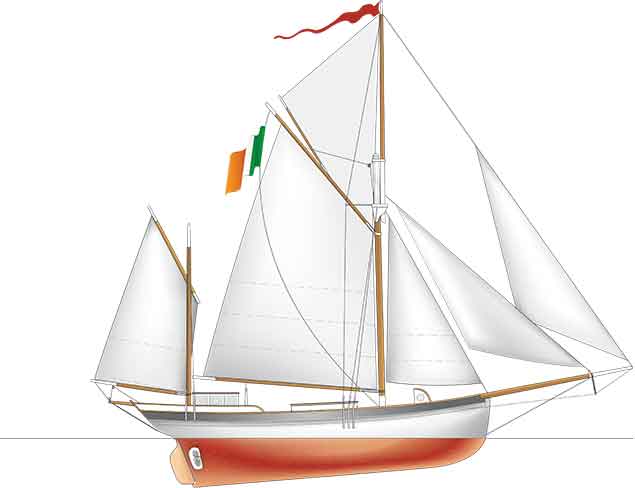 Grey (above) or Green (below) for Ilen's hull? Vote in our poll below
Grey (above) or Green (below) for Ilen's hull? Vote in our poll below
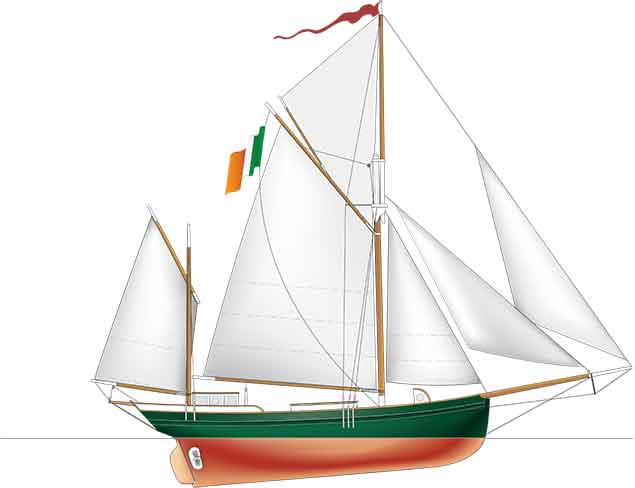
- Votes: (0%)
- Votes: (0%)


| Total Votes: | |
| First Vote: | |
| Last Vote: |
In Irish Sailing, The West's Awake
There is really no reasonable comparison between Ireland’s eastern and western seaboards writes W M Nixon. The east coast is quite densely populated, and while it has some areas of impressive scenery, in general it lacks the majestic inlets and islands which make sailing the Atlantic seaboard such a joy. That said, there’s no getting away from the fact that, taken overall, the east coast leads in economic activity, and at the very least there’s no doubting it has much less rain.
But when the rain in the west clears to reveal the coastline in all its glory, the extra precipitation seems a small price to pay for such visual natural abundance. And then too, while there are fewer people, they’re all so much larger than life, and bursting with innovative and entertaining ideas, that you’re inclined to think one western person is worth a dozen easterners.
However, those of us living and doing most of our sailing on the humdrum old east coast have one inescapable and total advantage over those in the west. When our east coast life gets too stressed and samey, we can escape for a while to the big country, fresh air and crazy attitudes of the west.
If you live in the west, you simply can’t genuinely experience this moment of release. But on the east coast, if life gets tedious, all that is necessary is head west for a day or two. The moment you cross the River Shannon, the spirits lift, and as you crest the watershed between the Shannon and Galway Bay, the big generous country of the west is rising on the horizon, and all is much better with the world.
In the west, too, they operate on a different time scale. And they do it in a different time zone. Until the railways of the 19th Century made some national co-ordination of time essential, local time meant that the recognised noon was later the further west you moved. As is only natural, Galway was twenty minutes later than Dublin. It was only with the exigencies of the Great War in 1916 that an Official Act was passed making uniform time-keeping a legal requirement. Oddly enough, no-one seems to have discussed what effect this draconian measure might have had in provoking the outbreak of the Easter Rising in 1916. Be that as it may, all we know for now is that in Galway, they still operate on a local time zone which is at least twenty minutes later than everyone else’s time, and is probably nearer half an hour.
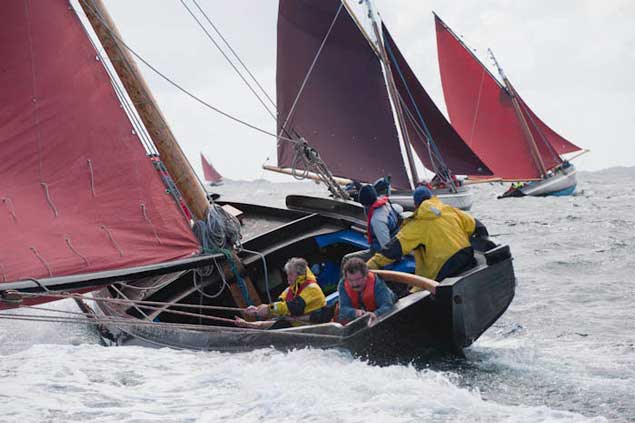 Galway hookers racing hard off the Connemara coast. This is the popular image of sailing in the west, but while vivid and true, the complete story of western sailing is much broader. Photo Paul Harris
Galway hookers racing hard off the Connemara coast. This is the popular image of sailing in the west, but while vivid and true, the complete story of western sailing is much broader. Photo Paul Harris
This became apparent last week when I wheeled into the car park at Galway Bay Sailing Club to give a performance of the current illustrated warblefest, which is about Ireland’s unique relationship with gaff rig and how it has emerged that Irish sailors led the switchover to Bermudan. The details of that will have to wait for another blog, but on this particular night, the immediate concern – with less than a quarter of an hour to go to the advertised start time – was that there just one other car in the car park, and that was Vice Commodore John Murphy, who was there a minute earlier to open the place up for the night.
“Oh Jaysus, Nixon” thought I, “you’ve bombed tonight, there’s not going to be a soul here.” But there wasn’t a moment to brood on the prospect of a showbiz flop, for I was with Pierce Purcell the mover and shaker of the west, and he wanted to show me the almost-finished refurb job they’ve been doing on the ground floor setup in the clubhouse, where they’ve managed to greatly enlarge the floor-space and rationalise its use for a state-of-the art changing room and multiple-use room and boat and equipment store setup.
You know the feeling you get when you’re looking at a job which is going very well indeed. It’s heartening. The re-furb in GBSC is precisely that. It’s being overseen by members Pat and Emer Irwin - he’s the Project Manager and she’s the Architect – and is being done with exemplary efficiency, on time and within a budget of only €160,000, which is the best value in building work I’ve ever seen anywhere.
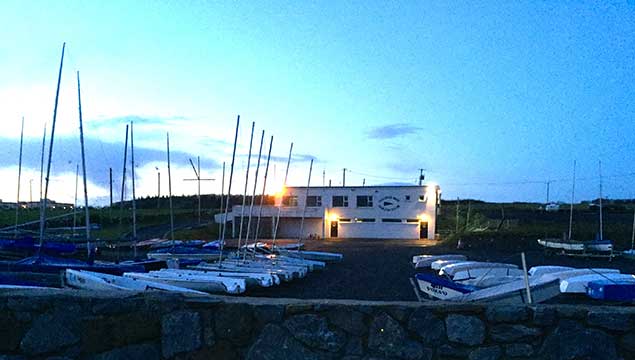 Galway Bay SC is nearing the completion of a clever refurbishment project which is within time, within budget, and excellent value. Photo Pierce Purcell
Galway Bay SC is nearing the completion of a clever refurbishment project which is within time, within budget, and excellent value. Photo Pierce Purcell
We emerged much encouraged from seeing all this to be further cheered by the fact the club was warming up with its famous big stove in the middle of the bar getting into its stride, and the place filling up with people from near and far. For of course I’d temporarily forgotten that Galway’s in a different time zone and it wouldn’t be until around 8.30pm that we’d have some idea of the real turnout, and how effective it might be for the yellow welly collection. This is an idea imported from Poolbeg Y & BC which provides the most painless way of raising funds for the lifeboats. You just provide one yellow RNLI seaboot and request the audience to see how many €5 notes they can get into it. Usually it concludes with some worthwhile figure inevitably ending in either zero or five, but Galway being Galway, the night concluded with the boot yielded up a sum ending with six euro and eight cents……
The show became something we all had to go through with, just in order to justify being there, so it went ahead and finally got to its meandering conclusion. Then the lights went up to reveal even more people had arrived. Pierce Purcell had certainly done his stuff in the phonecall chivvying department, for despite all your modern means of instant total-cover communication, the personal phone call seems to be more important than ever, and the photo below gives some indication of the coverage he achieved, while also hinting at the conviviality of an evening in which a shared love of boats and sailing and a good club atmosphere completely obliterated any feeling of it still being winter outside.
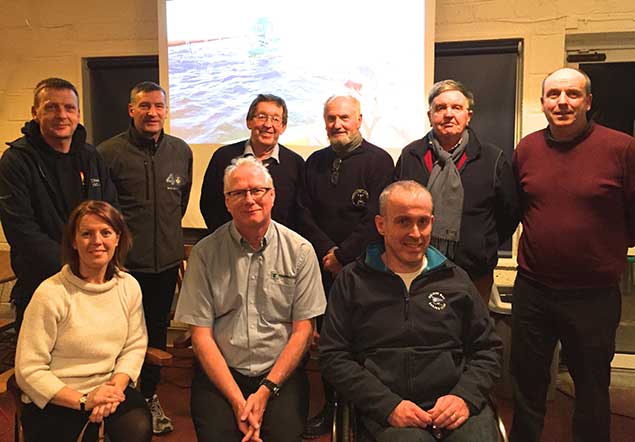 Western gathering. In Galway Bay SC are (back row, left to right) Simon McGibney (Commodore ICRA & ISA Board Member), John Leech (Commodore, Lough Derg YC), Afloat.ie’s W M Nixon, Adrian McConnell (Royal Western YC, Kilrush), Peter Fernie (Rear Commodore Irish Cruising Club) and Richard Glynn (Commodore, Royal Western of Ireland YC). Front row left to right Elaine O’Mahony, (outgoing Hon Sec Foynes YC, 2016 Volvo ISA Training Centre of the Year), Cormac McDonnacha (Chairman, WIORA Week), and Gary Allen, outgoing Commodore GBSC. Photo: Pierce Purcell
Western gathering. In Galway Bay SC are (back row, left to right) Simon McGibney (Commodore ICRA & ISA Board Member), John Leech (Commodore, Lough Derg YC), Afloat.ie’s W M Nixon, Adrian McConnell (Royal Western YC, Kilrush), Peter Fernie (Rear Commodore Irish Cruising Club) and Richard Glynn (Commodore, Royal Western of Ireland YC). Front row left to right Elaine O’Mahony, (outgoing Hon Sec Foynes YC, 2016 Volvo ISA Training Centre of the Year), Cormac McDonnacha (Chairman, WIORA Week), and Gary Allen, outgoing Commodore GBSC. Photo: Pierce Purcell
It was good to talk again with Barry Martin of Galway who made such an impact as bo’sun on the Asgard II many years ago that he found himself being recruited into the same role for both the much larger Britsh sail training schooners Winston Churchill and Malcolm Millar, a job in which he was so successful that he ended his sail training career as a senior officer on the Churchill.
There too were Jim Grealish and Barry Heskin, against whom we used to race inshore and offshore in the days when we each had boats around the 35ft size, boats of very different type yet rating notably similar, so if the Morrisssey-Grealish-Heskin squad appeared on the starting line with Joggernaut, aboard Witchcraft of Howth we knew we were into a boat-for-boat battle in which no quarter would be given, yet everyone would be the best of friends afterwards.
But if there was ample opportunity in GBSC for memories of good times past, equally there was plenty of discussion of the here and now, and it was fascinating to meet up with Dan Mill who runs the busy boatyard in the industrial estate beside Galway Docks. Dan’s story is such that we’ll be developing it into a complete blog in due course, sufficient to say at the moment that his links to Ireland are extraordinarily complex, for although he was born in England, at the age of three his parents together with another family set off to sail to New Zealand from Lymington in the then-bermudan-rigged 43ft Tyrrell ketch Maybird, and Maybird of course is now back in Ireland fully restored as a gaff ketch, and well-known in the ownership of Darryl Hughes.
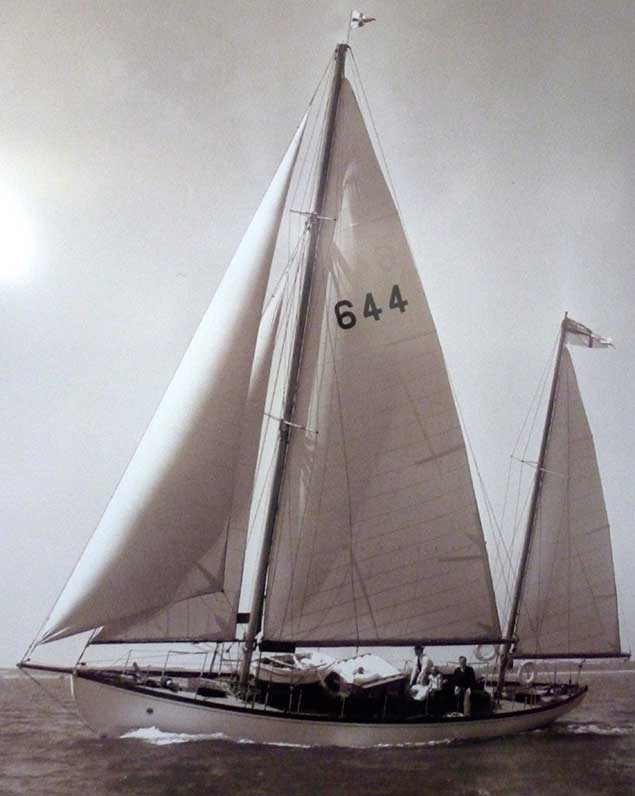 Maybird as a Bermudan ketch. It was under this rig that Dan Mill sailed on her from England to New Zealand while still a child
Maybird as a Bermudan ketch. It was under this rig that Dan Mill sailed on her from England to New Zealand while still a child
As for young Dan, growing up in New Zealand he naturally moved into boat-building in what is probably the best boat-building school in the world, the New Zealand marine industry. But then Mna na hEireann took a hand in his life-path.
It would be difficult to overestimate the influence that the charms of the Women of Ireland have had on the development of a small yet top-level boat-building industry in this country. But there’s something about marine craftsmen and Irish women which gets them together and entices the craftsmen to settle in Ireland despite the fact that, let’s face it, anyone trying to produce such top quality work here is ploughing a lonely furrow a long way from the great centres of the specialist industry, such as the Solent district, parts of the Baltic, certain places in Brittany, and particularly New Zealand.
Yet the women get them, and they get them home to Ireland, and they keep them. Thus we have the likes of Dan Mill in Galway, Steve Morris in Kilrush, and Bill Trafford in the hidden depths of the country near Mitchellstown, all three of them trying to ensure work of the highest quality in a country where “Ah sure, ’twill do” is sometimes the defining motto in woodwork.
Having arrived in Galway, Dan Mill found himself within the orbit of the formidable John Killeen, with whom all ideas are possible, and somehow they found themselves setting out to build a cruising version of an Open 60.
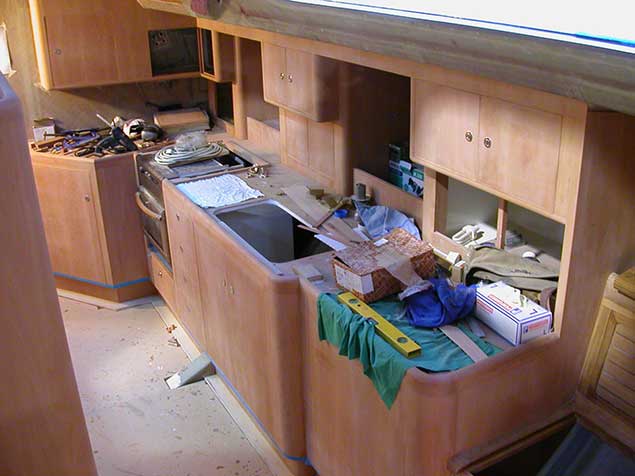 The galley area in Nimmo under construction
The galley area in Nimmo under construction
 Beauty in detail – Dan Mill’s craftsmanship in evidence on a table for Nimmo.
Beauty in detail – Dan Mill’s craftsmanship in evidence on a table for Nimmo.
In the end she became a very one-off 68-footer named Nimmo in honour of the great Scottish harbour engineer Alexander Nimmo, who is one of John’s heroes. When she was eventually finished after four years with Dan being responsible for virtually every bit of skilled work in her complex construction and superb finish, he was exhausted, but his reputation in Galway was well established at a very high level, and he’s now the man to go to with boat maintenance needs and problems. He’s not above undertaking a mid-level job such as putting a new deck and coachroof on an older fibreglass hull, but as for launching another project on the Nimmo scale, that would require some thinking about.
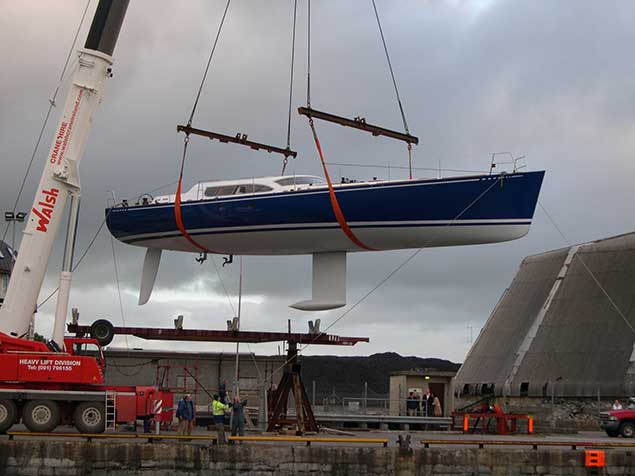 Launching day for Nimmo, built in a very basic shed in Galway
Launching day for Nimmo, built in a very basic shed in Galway Dan Mill this week in the boat yard in Galway
Dan Mill this week in the boat yard in Galway
Nevertheless, talking with the man who built Nimmo was an eloquent reminder that there’s a lot more to sailing in the West than Galway Hookers and other traditional craft. But equally it was a reminder that the traditional skills are still being maintained and indeed nourished out beyond the Pale. So after a leisurely breakfast next morning with Pierce and Susan Purcell in their dream house in Clarinbridge, with a busy red squirrel feasting on the bird table close outside the generous window, there was time to inspect Pierce’s boatshed out the back, one of those green steel sheds which sit so well in the Irish countryside, particularly when – like Pierce – you have your 26-footer comfortably winterised in it, and a fine well-equipped workbench right to hand.
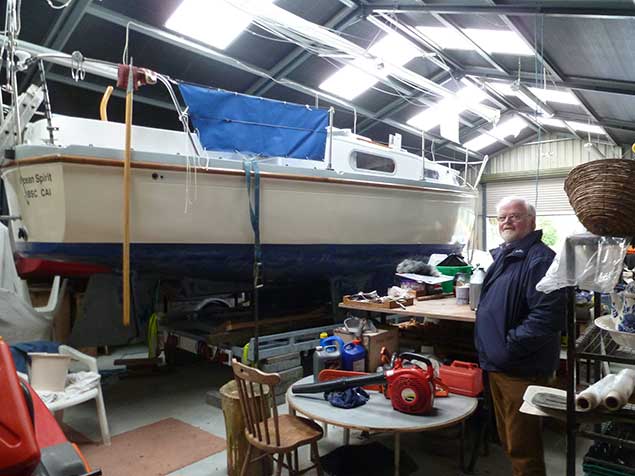 What price a facility like this at your house on the East Coast? Pierce Purcell in “the little shed out the back” at Clarenbridge Photo W M Nixon
What price a facility like this at your house on the East Coast? Pierce Purcell in “the little shed out the back” at Clarenbridge Photo W M Nixon
It’s the sort of ideal setup very few can manage on the over-crowded East Coast, and I headed south musing on the east-west imbalance, and readying the thinking for something entirely different - the Ilen Boat-Building School in Limerick. This started as the backup service for the restoration of the Conor O’Brien 57ft ketch Ilen by Liam Hegarty at Oldcourt near Baltimore, and recently in the Ilen School they’ve produced deckhouses for Ilen to the highest standard, and are currently finishing the last of the new spars.
But under the inspiration of Gary MacMahon (who personally was responsible for bring Ilen home from the Falklands) and others such as Brother Anthony Keane of Glenstal Abbey, the Ilen School has become a remarkable educational and training resource undertaking a wide variety of projects such as creating replicas of the traditional Shannon Estuary gandelows, and building a class of the very handy CityOne sailing dinghies to a design by the late Theo Rye, a successful project which further revealed the multiple talents of that much-mourned expert in every aspect of naval architecture.
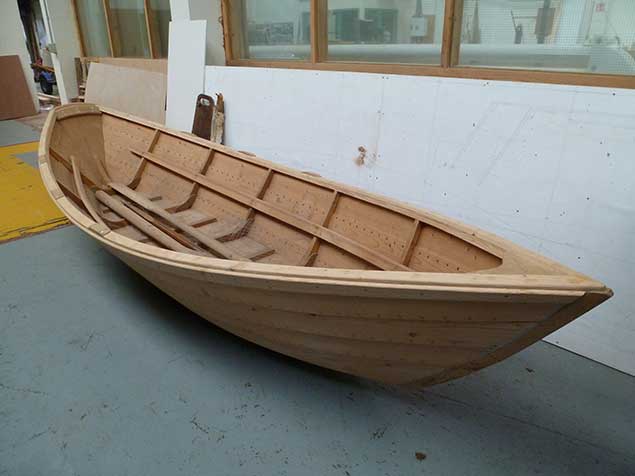 Courses constructing traditional Grand Banks Dories provide popular night classes at the Ilen Boatbuilding School in Limerick. Photo W M Nixon
Courses constructing traditional Grand Banks Dories provide popular night classes at the Ilen Boatbuilding School in Limerick. Photo W M Nixon
Another handy course which the Ilen School offers is through building traditional Grand Banks dories, simple yet effective boats which must have seemed very small indeed as you were left behind in the Grand Banks fog by the Bluenose fishing schooners to get on with the day’s business of ling-lining for cod. By the time the schooner found you again towards evening, your little dory would be dangerously laden with a great catch of wet and scaly silvery wealth.
In fact, the Ilen School is a whole host of experiences, for there in the main work-space were the mighty new spars for Ilen together with the distinctly aged original gaff which goes all the way back to Tom Moynihan and his shipwrights in Baltimore 91 years ago. And in another workspace, the Ilen team are building two very able little dinghies to the Valentine type from dimensions supplied by Hal Sisk, and they will in time be Ilen’s boats. But before you get to these sensibly–shaped little dinghies, you’ve to take on board the Hildasay, the Ilen school’s latest acquisition.
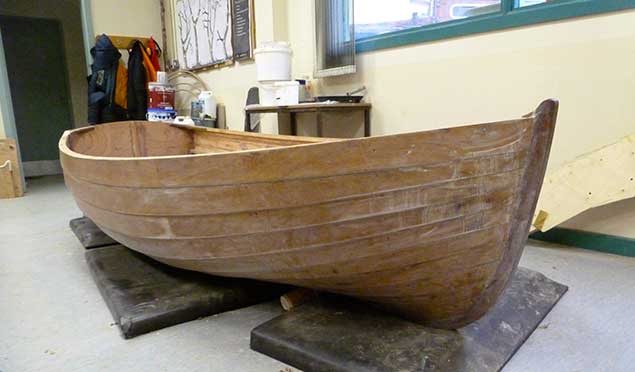 The Valentine dinghy, from plans provided by Hal Sisk, has been built at the school to be a ship’s boat for Ilen. Photo W M Nixon
The Valentine dinghy, from plans provided by Hal Sisk, has been built at the school to be a ship’s boat for Ilen. Photo W M Nixon
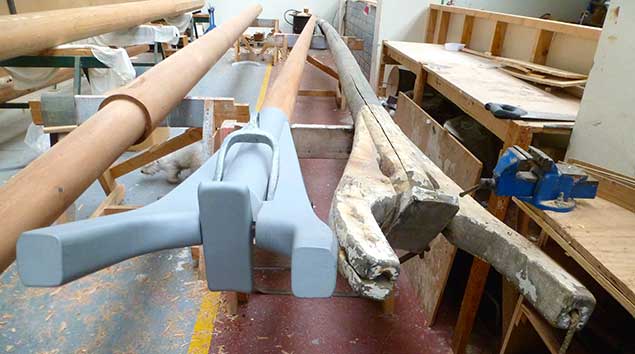 Ilen’s new main gaff boom (left) and the original (right), which was shaped in Baltimore in 1926. Photo W M Nixon
Ilen’s new main gaff boom (left) and the original (right), which was shaped in Baltimore in 1926. Photo W M Nixon
 The mighty mainmast for Ilen, with topmast temporarily in place in Limerick, is ready for dismantling and transport to Baltimore. Photo W M Nixon
The mighty mainmast for Ilen, with topmast temporarily in place in Limerick, is ready for dismantling and transport to Baltimore. Photo W M Nixon
We all know that Limerick is a Viking city, in fact there are those who would argue that it still is, and in its rawest state too. But nevertheless it takes a while to get your head round how a boat like Hildasay, of the very purest Viking descent, should have ended up in a big shed in a trading estate in Limerick.
Hildasay was built in Shetland as a sailing development of the traditional clinker-built sixareen (six oars) in 1951, and is such a sweet little 26-footer that your heart falls for her, even if your head tells you that the slim Viking stern mean there’s very little space just where you most need it most, while the classic clinker construction poses its own special maintenance problems in a vessel which is a semi-keelboat.
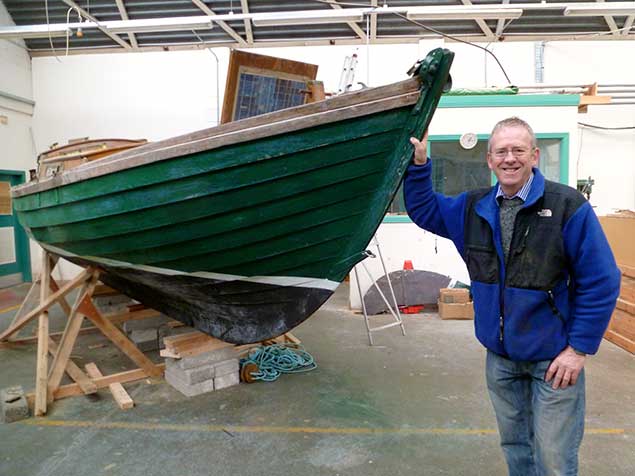 Jack Hawks with the Shetland sailing sixareen Hildasay, whuch he has donated to the Ilen Boatbuilding School. Photo: W M Nixon
Jack Hawks with the Shetland sailing sixareen Hildasay, whuch he has donated to the Ilen Boatbuilding School. Photo: W M Nixon
She has been in and around the Shannon Estuary for abut 15 years, but owner Jack Hawks was recently seriously ill, and though he has fully recovered he felt the demands of Hildasay were getting a little too much for him, and wondered if the Ilen Boat Building School would be interested in her as a gift.
She’s an ideal gift, as she’s of a size to be very manageable, she provides special maintenance problems which, while not enormous, are very educational as part of the school’s courses, and each summer when she’s in commission she could be based either on Lough Derg, or somewhere down the Estuary.
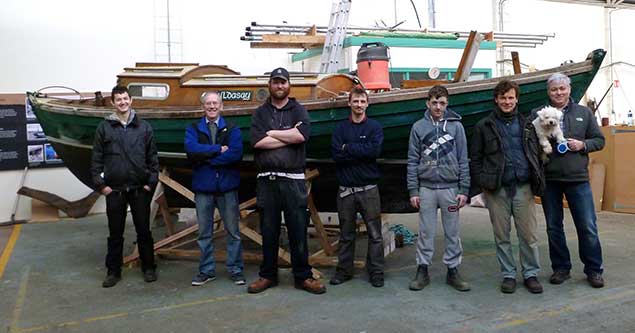 The “day team” at the Ilen School with their new acquisition Hildasay include Luki O’Brien, Jack Hawks, Elan Bromley, Owen Lacey, Sid Dorchenas, Matt Diss, Gary MacMahon and Luna MacMahon. Photo W M Nixon
The “day team” at the Ilen School with their new acquisition Hildasay include Luki O’Brien, Jack Hawks, Elan Bromley, Owen Lacey, Sid Dorchenas, Matt Diss, Gary MacMahon and Luna MacMahon. Photo W M Nixon
The problem in Limerick is that though the Shannon is very much in the midst of it, access to it in the heart of town is limited, and in any case below the weir the big tides are a problem. But up on Lough Derg or further down the Estuary, there are all sorts of opportunities to get conveniently afloat, and having the use of an interesting sailing boat which is bigger than a CityOne or a gandelow is a natural add-on to the Ilen School’s activities, providing a broadening of the mind for some young would-be boatbuilders who may have spent too much time solely at the workbench without seeing what the resulting use of the end product is all about. And who knows, but they might even manage a race with the lovely gaff cutter Sally O’Keeffe built by Steve Morris of Kilrush with the community team from nearby Querrin as a replica of the traditional Shannon Estuary trading hooker.
Having seen the possibilities of mind-broadening in Limerick, the final part of this western tour took in a project which is mind-blowing. Admittedly the good people of the townland of Skenakilla would never for a minute think of themselves as being in the west, but for the rest of us this hidden spot beyond Mitchellstown in North Cork seems to be in the middle of nowhere. But then when you’ve found it, and spent a bit of time with the ebullient Bill Trafford in his remarkable Alchemy Marine boat workshop in Skenakilla, you feel you’re at the hub of the universe.
Bill is another case of Mna na hEireann reeling them in – a classic yachtbuilder and particularly an enthusiast for the International 6 Metre Class, he met an Irish girl and that was that. He made a living plying his highly specialized trade the length and breadth of our island working from a van, and then discovered his own niche in doing interesting, indeed extraordinary things, with old fibreglass boats.
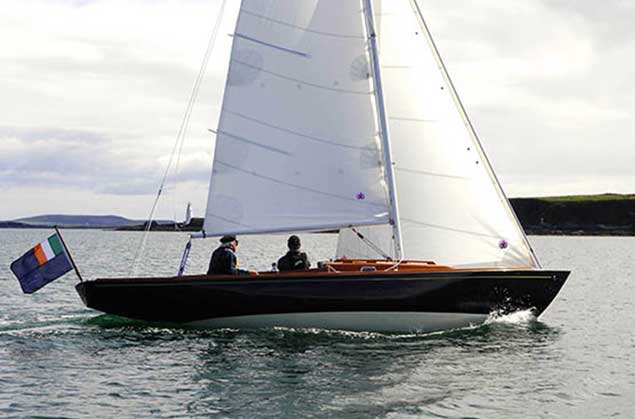 Bill Trafford’s transformation of an Elizabethan 23 won international awards last year.
Bill Trafford’s transformation of an Elizabethan 23 won international awards last year.
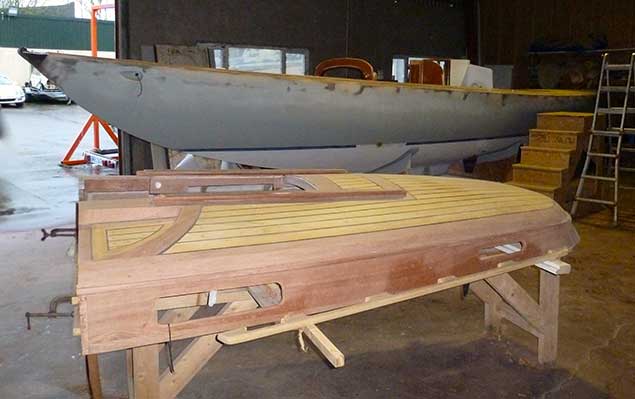 Bill Trafford’s current project at Alchemy Marine is the transformation of an Etchells 22 into a weekend cruiser by raising the freeboard, and providing a beautifully-made coachroof (foreground) Photo: W M Nixon
Bill Trafford’s current project at Alchemy Marine is the transformation of an Etchells 22 into a weekend cruiser by raising the freeboard, and providing a beautifully-made coachroof (foreground) Photo: W M Nixon
 Bill Trafford – he is as enthusiastic about the full potential of glassfibre construction as he is about using classic yacht joinery work. Photo W M Nixon
Bill Trafford – he is as enthusiastic about the full potential of glassfibre construction as he is about using classic yacht joinery work. Photo W M Nixon
He’s unusual in that he’s as enthusiastic about the wide potential of glassfibre construction as he is profoundly satisfied by working in wood to the highest classic yacht standards. While his special abilities were well known to a select few, he came to international notice last year when one of his masterpieces, the complete re-working of a seemingly tired little Elizabthan 23 into an elegant 26ft sloop with a classic New England style, was awarded a top prize in the Classic Boat annual competition.
His current project for a Cork owner is even more intriguing, the transformation of an ordinary and no longer young Etchells 22 into a 34ft LOA day cruiser of unique appearance. He has raised the topsides using glassfibre moulding to give her a completely fresh sheerline, he has transformed the stern by giving it a new-look counter with a curving transom which gives more than a nod in the direction of the unique sterns of the Friendship sloops of Maine, and he has built the most beautiful coachroof in the best Knud Reimers style to provide a boat which comes with a heady combination of Down East and Scandinavia to her.
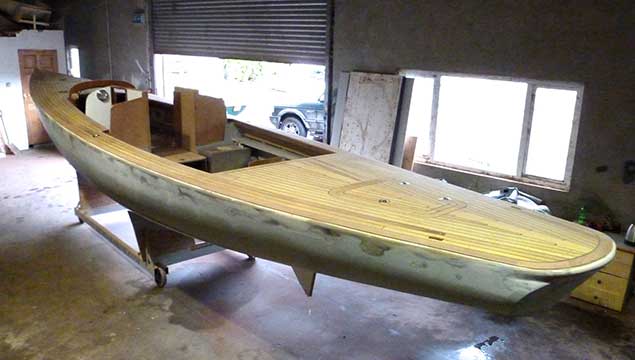 The lengthened stern has seen the rudder being moved aft by half a metre to provide a much roomier cockpit. Photo: W M Nixon
The lengthened stern has seen the rudder being moved aft by half a metre to provide a much roomier cockpit. Photo: W M Nixon
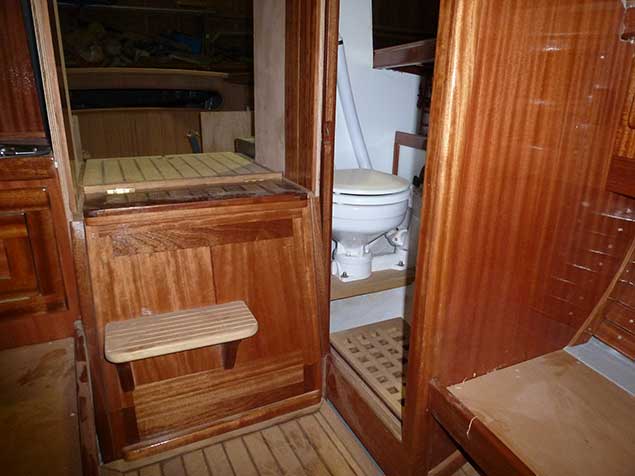 While compact, the accommodation provides for weekend cruising, but it’s expected to be comfortable day sailing which will be the best use of the “new” boat. Photo: W M Nixon
While compact, the accommodation provides for weekend cruising, but it’s expected to be comfortable day sailing which will be the best use of the “new” boat. Photo: W M Nixon
The stern is lengthened such that the LOA is now 34ft instead of the original 30.5ft, and the possibilities this has provided for a large cockpit to match the very pleasant accommodation (including a proper toilet compartment and a Beta diesel auxiliary) have been met by moving the entire rudder half a metre aft.
With his experience of tweaking boats this way and that, Bill reckons the sailing balance will if anything be improved by this re-location of the rudder. Personally, in the standard Etchells I’d always thought it too far forward anyway, so I could live with this change, yet found it entertaining to note that while he talked of moving the rudder aft by half a metre, when I asked him how he calculated the perfect-looking camber in the new deck, he said his rule of thumb is one inch for every four feet of beam. This is as near as dammit one in fifty, but his mixture of measurement systems makes him just like the rest of us who are mere bodgers, for when we’re measuring something we just use the side of the steel rule which comes up first, be it metric or imperial…….
 Under the new foredeck – Bill’s rule of thumb is a deck camber of one in 48. Photo: W M Nixon
Under the new foredeck – Bill’s rule of thumb is a deck camber of one in 48. Photo: W M Nixon
This is very much a bespoke project, so Bill has been able to introduce all sorts of quirky little features, a very attractive one being the ports for the navigation lights, which are set well into the hull either side of the stemhead, and look for all the world like the eyes put in Mediterranean boats to ward off evil spirits. In fact, they give such an appearance of good cheer to this new-old boat that when you see her from ahead, she looks for all the world as though she is smiling so much that she’s about to burst out laughing.
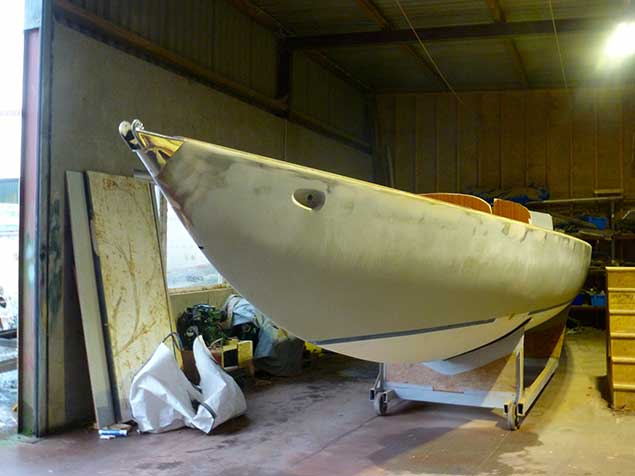 The Watchful One…….it was a Bill Trafford’s idea to build special ports for the navigation lights. Photo W M Nixon
The Watchful One…….it was a Bill Trafford’s idea to build special ports for the navigation lights. Photo W M Nixon
There’s still quite a bit to do before she’s ready for the water, but Bill is now in such a rhythm of working on his own that he can put in long productive hours without really noticing it, so we hope to get back to Skenakilla sooner rather than later. As for those around him, one unexpected advantage of being near Mitchellstown is you’re right in the heart of the dairy engineering industry, where the use and working of stainless steel is second nature. In fact, down there they sometimes use stainless steel which is of a superior grade to the 316 which is usually good enough for the rest of us.
Truth to tell, I didn’t know there were types of stainless steel superior to 316, but you learn many things down in Skenakilla, and it was encouraging to hear that the best workers in the stainless steel fabricating shops are happy to lend their skills in their spare time to bring Bill’s self-made stainless steel fittings up to professional standards of finish.
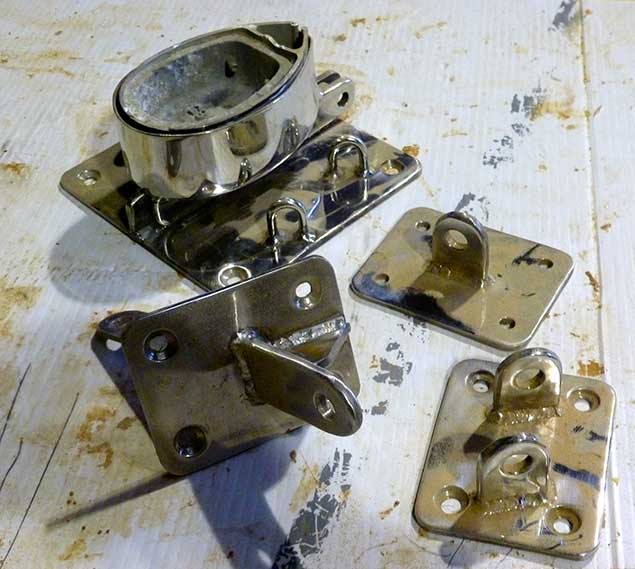 Thanks to the local presence of high-grade stainless steel engineering for the dairy industry, it has been possible to make these fittings in Skenakilla. Photo: W M Nixon
Thanks to the local presence of high-grade stainless steel engineering for the dairy industry, it has been possible to make these fittings in Skenakilla. Photo: W M Nixon
 A work of art in its own right, the new coachroof will be fitted any day now. Photo: W M Nixon
A work of art in its own right, the new coachroof will be fitted any day now. Photo: W M Nixon
All being well, the new boat will be a star at the 25th Anniversary Glandore Classics Regatta from July 23rd to 29th, in fact Bill rather hopes the owner might consider taking her to the Classics Regatta celebrating the Bicentenary of Dun Laoghaire Harbour from July 6th to 9th as part of Volvo Dun Laoghaire Regatta.
The good news here is that Cathy MacAleavey, chair of the Dun Laoghaire Classics organising committee, and Sally Wyles, who heads up the Glandore organisation, got together last weekend to see about selling their two events as a sort of package, as the clear fortnight between them makes participation in both a very realistic proposition.
Certainly the Dun Laoghaire Classics is beginning to look impressive, particularly if you go by the measuring method of counting the number of famous designers involved. The recent interest shown by Rob Mason of Milford Haven to come over with his newly-restored 36ft Alexander Richardson-designed 36ft Myfanwy brings a once-famous Liverpool designer back into the limelight. It’s where he deserves to be, for Richardson designed John Jameson’s all-conquering Irex in 1884.
 Rob Mason with his restored 1897 Alexander Richardson 36-footer Myfanwy off Milford Haven. He has indicated interest in participation in the Bicentenary Regatta in Dun Laoghaire in July
Rob Mason with his restored 1897 Alexander Richardson 36-footer Myfanwy off Milford Haven. He has indicated interest in participation in the Bicentenary Regatta in Dun Laoghaire in July
In Dublin Bay, Myfanwy would see this Richardson creation shaping up to designs by G L Watson, Alfred Mylne, William Fife, John Kearney, O’Brien Kennedy, Arthur Robb and others, and that’s the list already with the net only newly cast.
As for what Glandore can offer, there’s at least one unique proposition. A special race will be sailed to honour the memory of Theo Rye, the fleet including the CityOnes from Limerick and a host of other boats, new and old. On each and every one of them, Theo would have had something new and of real interest to say, for that’s the kind of devoted student of naval architecture he was throughout his far-too-short life. He is much missed.
 Much missed. The late Theo Rye aboard the 1887 Fife cutter Ayrshire Lass, which was restored by Michael Kennedy at Dunmore East. Theo Rye will be commemorated in a special event at the 25th Anniversary Glandore Classics Regatta from July 23rd to 29th. Photo: Darryl Hughes
Much missed. The late Theo Rye aboard the 1887 Fife cutter Ayrshire Lass, which was restored by Michael Kennedy at Dunmore East. Theo Rye will be commemorated in a special event at the 25th Anniversary Glandore Classics Regatta from July 23rd to 29th. Photo: Darryl Hughes
The latest photos of the restoration work on Ireland's only remaining Sail–Trader Ilen reveal wonderful new Larch planked bulwarks are begining to embrace the 56–ft sailing ketch. They will be expected to shoulder many an Atlantic sea, according to Gary MacMahon, of the Ilen restoration school.
Ilen is expected to be a show–piece attraction at July's Glandore classic boat regatta, As Afloat.ie reported earlier.
The ketch was built in 1926 in the Baltimore Fishery School Boatyard for the Falkland Islands Company.
She was designed and sailed to the Falkland Islands by Conor O'Brien, who in 1925, was the first Irishman to complete a circumnavigation of the world in the 42-ft ketch, Saoirse, also built in Baltimore.

Restored Sail Trader 'Ilen' To Grace 25th Glandore Classic Boat Festival
Glandore Classic Boat Regatta celebrates its 25th anniversary this July with a Parade of Sail that will feature the fully restored AK Ilen, Ireland's sole surviving Sail Trader.
There will be four days of first class racing, with eight different classes so far plus a ‘cruise in company’ to Castletownshend from July 23–28 as part of the Glandore regatta line–up.
A demonstration of ‘synchronised sailing’ from the Dublin Bay Water Wags will also be a regatta highlight.
Ilen, a centre–piece of the West Cork event, is a 56-ft sailing ketch that was built in 1926 in the Baltimore Fishery School Boatyard for the Falkland Islands Company.
She was designed and sailed to the Falkland Islands by Conor O'Brien, who in 1925, was the first Irishman to complete a circumnavigation of the world in the 42-ft ketch, Saoirse, also built in Baltimore.
The Ilen served seventy years as a trading vessel in the tempestuous seas of the South Atlantic before being brought back to Ireland in 1998.
Now nearing completion, Ilen is the focal point for a remarkable maritime project embracing the A.K. Ilen School for wooden boatbuilding in Limerick and Hegarty's boatyard in Oldcourt.
Joining Ilen in Glandore, elegant classic boats like Peggy Bawn, Celtic Mist, Spirit of Oysterhaven, Peel Castle and Big Momma will also be part of the historic parade of sail.
One very interesting participating boat will be the Naomh Lua, a 1954 Watson which served as the lifeboat for Shannon Airport for 30 years, built to rescue 120 passengers from the Shannon estuary.
 Glandore harbour from sea. Photo courtesy: Dennis Horgan
Glandore harbour from sea. Photo courtesy: Dennis Horgan
The 25th anniversary regatta will be opened by Dee Forbes, the Director General of RTÉ, the first woman to hold the role in the state broadcaster.
Classic cars will be coming through the village on Sunday 23rd, and there will be classic West Cork craic in the pubs and restaurants after each daily prize giving, including music and dancing in the street.
For hungry sailors coming off the water there will be food trucks on the pier for instant snacks, and BBQ facilities will be available in the GHYC yard for those living on board who are self-catering.
For non-sailors guided walks will be available, including to the famous Drombeg Stone Circle. Sea kayaking, deep sea fishing, and whale watching are all available from Union Hall, across the harbour.
Traditional Ketch Ilen’s Restored Deck Completed in Community & Celebrity Ceremony in West Cork
The restoration of the 57–ft traditional multi-cargo ketch Ilen, built in Baltimore in 1926, has taken a significant step forward through the formal closing of her deck with the ceremonial fastening home of the final plank at Liam Hegarty’s boatyard at Oldcourt beside the River Ilen.
The ceremony, hosted on Saturday by the Ilen Project, Limerick, marked a significant milestone in a re-build project whose primary goal is to bring Ireland’s sole surviving wooden sailing ship back to Limerick. It was Limerick man Conor O’Brien of Foynes Island who secured the order for the Ilen when he called by the Falkland Islands after rounding Cape Horn in 1925 in his world-girdling 40ft Baltimore-built Saoirse. The islanders decided that a larger version of Saoirse would provide an ideal inter-island communication, transport and ferry vessel for their rugged archipelago, and within two years Conor O’Brien had returned with the Ilen to fulfill their commission.
 American shipwright Matt Dirr, one of the many international talents who has contributed his skills to the Ilen project, does some final tidying-up before the ceremony.
American shipwright Matt Dirr, one of the many international talents who has contributed his skills to the Ilen project, does some final tidying-up before the ceremony.
Saturday’s very special occasion revealed the beauty of the vessel to all those who attended - the high quality materials, the exemplary craftsmanship, and most significantly the marine educational role the vessel can be expected to play when she takes up her operational life on the Shannon Estuary and beyond, from her new home port of Limerick.
Brother Anthony Keane of Glenstal Abbey, a key promoter of the Ilen Project, officiated at the ceremony and said that what has been achieved so far showed that there was not alone a great work ethic in the Ilen Project but also a spiritual commitment to the work being done. "This is an amazing act of faith and commitment come to fruition. This boat, and the people involved with it, rock. It is heading for the sea, like a salmon, and it will not be stopped, even if some of the financial people have still to solve their problems of calculus and apply their mathematics. The faith, energy and skill of Liam Hegarty, John Hegarty, Fachtna O’Sullivan, and their team at Hegarty’s Boatyard are sufficient to tell a tree to be uprooted and launched into the sea, and see it happen. Their work is a phenomenon which outside administrators might better observe and study rather than direct or control.”
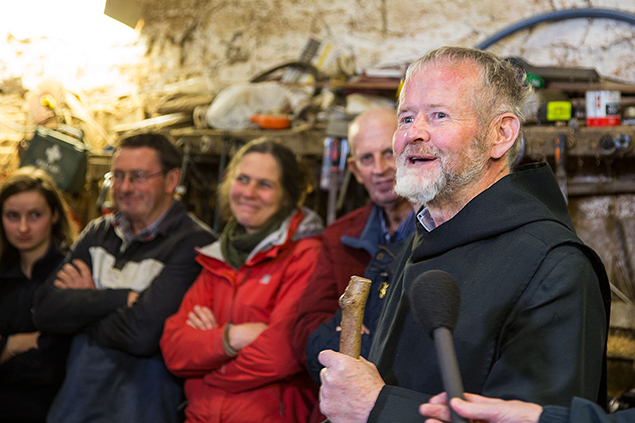 Brother Anthony Keane of Glenstal Abbey has been a key promoter of the Iken Project since its inception, and spoke with enthusiasm of all that it meant to those involved and to Limerick generally.
Brother Anthony Keane of Glenstal Abbey has been a key promoter of the Iken Project since its inception, and spoke with enthusiasm of all that it meant to those involved and to Limerick generally.
Ceremony guest speaker Lord David Puttnam said that "the project underlined what could be done by a determined community, a community that could make their decisions for themselves, not to be dependent upon others beyond their community, but to be self-sufficient, and the project of the Ilen showed that. It also demonstrated that the skills involved, and which were being taught, were skills which younger people could learn, use and remain in their community, without having to leave, and thus strengthen communities. This is a message from the Ilen project."
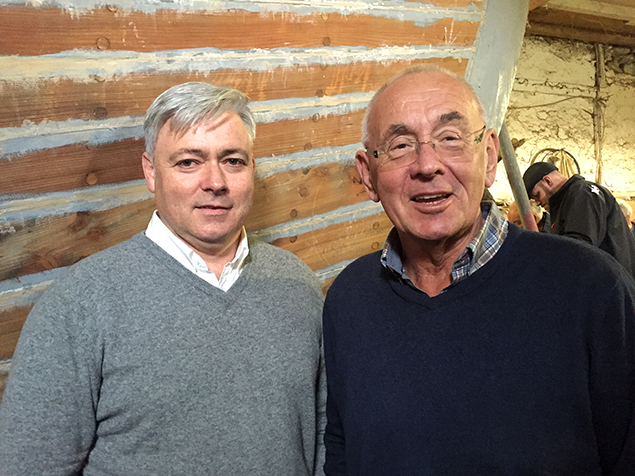 The supporters of the Ilen Project come from a wide range of backgrounds – this is Gary MacMahon, a director of the Ilen Boat-building School, with former Irish Cruising Club Commodore David Tucker of Kinsale.
The supporters of the Ilen Project come from a wide range of backgrounds – this is Gary MacMahon, a director of the Ilen Boat-building School, with former Irish Cruising Club Commodore David Tucker of Kinsale.
Dr Edward Walsh, founding president of the University of Limerick, also spoke, and told of how he had at the outset of the project exhorted all to simply “go ahead and buy the boat” and “pretend” that the money was there, and it was a source of great pride for him to see how it had advanced so far.
The good ship Ilen has advanced to this moment in time where she happily accepts this final plank. It has been a long journey, an arduous journey, which continues, but one which has reached a plateau, a place and time of wonder and of thanks.
In 1926 the Ilen, Ireland’s sole surviving wooden sailing ship, sailed from Limerick to an active 70 year working life in the South Atlantic, and the completion last Saturday of her new weather deck brings her return to seafaring a lot closer.
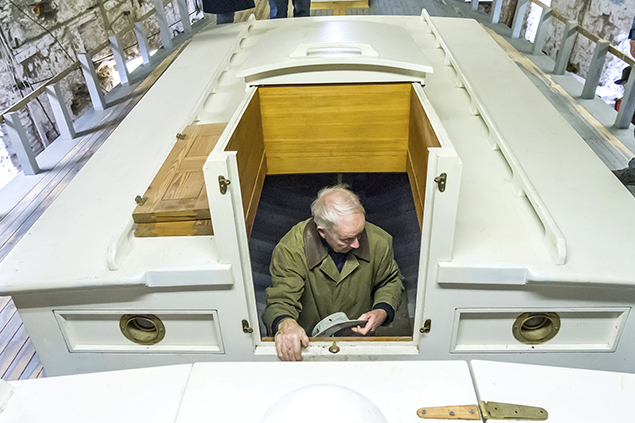 Dr Edward Walsh has a look-see down below. The founder of Limerick University encouraged the project from the start with his initial advice of “go head and buy the boat”, and since then funds have been raised from a wide variety of sources to keep the show on the road.
Dr Edward Walsh has a look-see down below. The founder of Limerick University encouraged the project from the start with his initial advice of “go head and buy the boat”, and since then funds have been raised from a wide variety of sources to keep the show on the road.
Saturday’s decking-out ceremony afforded all those who attended the unique opportunity to view the classic lines of the vessel, feel the reel of the heaving keel, admire her sheer, walk the new old growth Douglas Fir deck, or stand below deck amid her massive Irish oak frames - a tactile experiences unique to big wooden sailing ships.
And so Sinead Hegarty and Mary Jordan of Baltimore, hammered home the final deck plank with blows swift, sweet and true. The ship seemed imperceptibly to roll a little, looking forward to her sea trials.
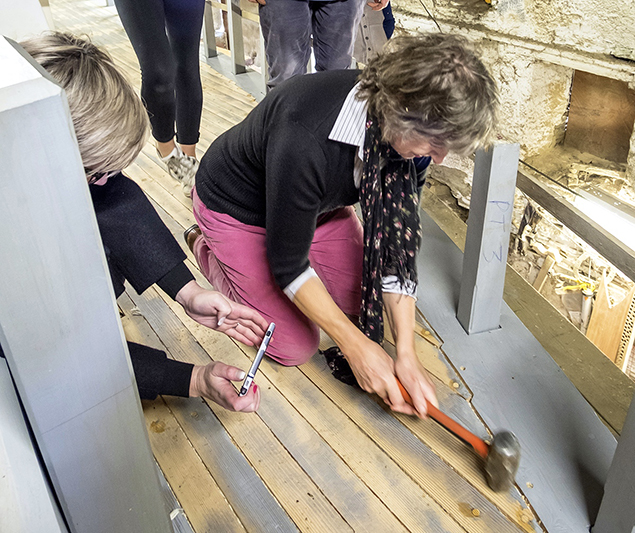 Job done. Mary Jordan of Baltimore drives home the final deck fastening. All photos Kevin O’Farrell, Baltimore
Job done. Mary Jordan of Baltimore drives home the final deck fastening. All photos Kevin O’Farrell, Baltimore
Podcast: Ilen's Bowsprit Brooks No Challenge
A 22–foot long bowsprit is an impressive sight. ‘Wow’ was my first reaction as I stood on the deck of the historic Ilen looking at it during the ‘decking-out’ ceremony for the vessel which I report on the new edition of THIS ISLAND NATION. It is not a bowsprit to be challenged and it will give the Ilen a distinctive and dominant presence when she goes in the water again. I am looking forward to that day at Hegarty’s Boatyard in Oldcourt near Skibbereen, in West Cork.
It will be some occasion and there is no doubt that it will happen. That was made clear at the ceremony where Conor O’Brien’s famous ketch, the last of Ireland’s traditional wooden sailing ships, now beautifully restored was the focal point of attention.
“There’s a lot still to be done, but this ship is building herself towards going in the water as the skilled people at this yard restore her and she will go in the water, of that you can be certain,” Gary told me. You can hear him on the programme and also Brother Anthony Keane from Glenstal Abbey who summarised the skill of wooden boat building which Liam Hegarty’s yard has demonstrated in the restoration project. And when you listen to the programme here, he has a bit of news for the Minister for Finance!
I have designed THIS ISLAND NATION to be a reflective, informative and entertaining programme about maritime matters… That’s what is regarded in radio land as a “niche programme…” and it’s one where your comments are always particularly welcome… by Email to: [email protected] or by phone to 0872 555197.
In this new edition you can also hear the words of Damien Brazil, Instructor in the Marine, Offshore Safety and Survival sector of the Fisheries and Marine Institute at the Memorial University of Newfoundland: "We always knew who we were. We came here Irish and we didn't change a whole lot.” He is a man with great knowledge of Ireland's maritime/historical connections. His people emigrated from Ballylongford in Co.Kerry.
With a little bit about jigging for squid; the story of what happened to a Lifeboatman on his wedding day and news about a development to prevent the theft of Ringbuoys as well as new volunteer rescue services in Sligo and Clare, this is an edition packed with maritime news, discussion, comment and information.
We well know from running stories now and again about the restoration of the Conor O’Brien 57ft ketch Ilen at Oldcourt near Baltimore for Limerick’s Ilen Boat-building School just what a high level of interest it arouses at home and abroad writes W M Nixon. So when this Community Invitation for the decking-out ceremony in nine days time pinged through the inbox, we thought for a moment about how best to publicise it. Then the spotting of a little typo allowed us to send a pompous email telling them that the curve of the top of the hull is the sheer, but if you want to shear, then you need sheep.
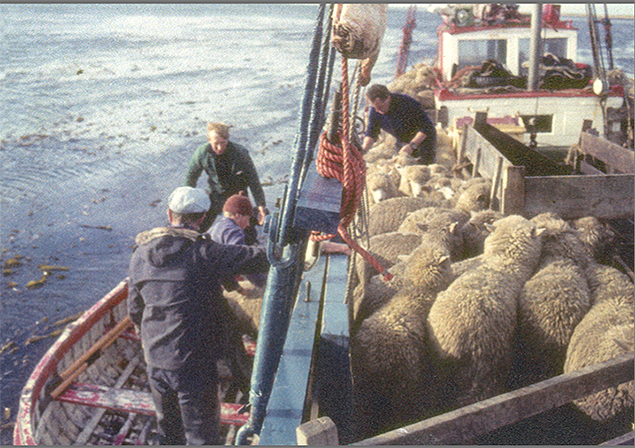 Ship sheep. Ilen takes aboard woolly passengers in her working days
Ship sheep. Ilen takes aboard woolly passengers in her working days
 Job done. After a successful shearing session, Ilen heads for home with bags of quality wool
Job done. After a successful shearing session, Ilen heads for home with bags of quality wool
You don’t pull the wool over the Limerick men’s eyes for long. Within minutes there came back the photo of Ilen’s deck well-filled with sheep during her working days in the Falkland Islands, and then another one with her foredeck topped-up with bags of wool after a successful shearing expedition.
That was followed in due course by a typo-free invite for the ceremony. It will be quite a party.
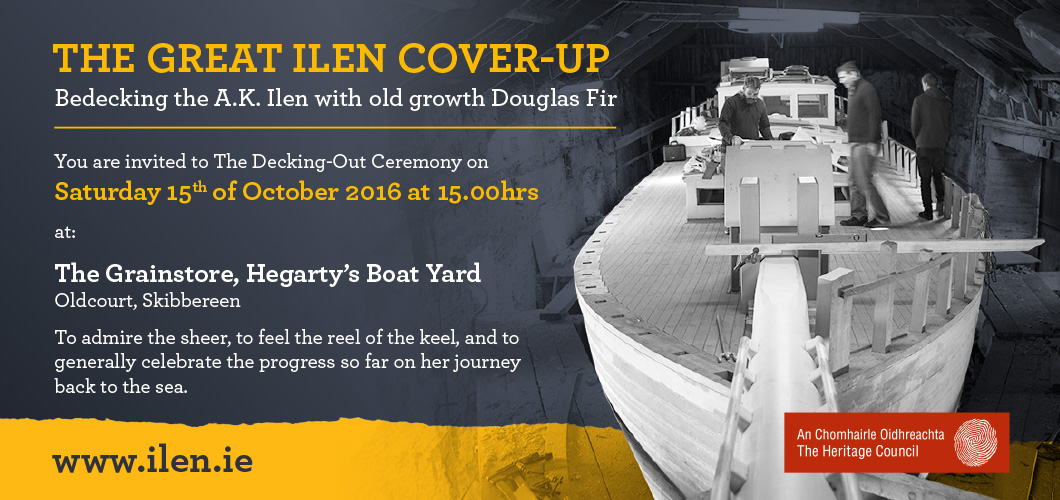 Ilen invitation all present and correct
Ilen invitation all present and correct
Last Saturday, October 2nd, at 5pm on the River Shannon in the heart of the city, the idea of a significant international rally and rowing race event for traditional craft was realised.
It’s a developing concept, an event in the making that has the potential to promote to the wider world the special pleasures of rowing Limerick’s many hidden waterways.
Thirty boats gathered on O’Callaghan Strand slip. They were all wonderful vernacular craft of the best traditional types, imbued with their owners’ characters, and manned with equally characterful crews who had travelled with their beloved boats from Cork, West Clare, Limerick and the adjacent boat-beds of Clarina, Coonagh, Ringmoylan and Askeaton, to make up a generous inaugural King’s Island Race fleet. The best of October weather came out in support as the rowers pulled east towards Thomond Bridge, to begin a wonderful inaugural King’s Island Race in warm sunshine.
"Visiting rowers to the city were more than surprised with the splendour of the city’s river environment, and particularly with how being in a small boat can so quickly put it in a fresh context” said Gary MacMahon, director of the Ilen School which hosted the event. “In fact” he added, "they were a bit disappointed we had not shared this metropolitan rowing pearl with them earlier…….At any rate, the secret has now escaped the city, as we at the Ilen.ie School plan to develop this King’s Island Race as a quality international annual river event for Limerick.” he confirmed.
 Kings Island on the north side of central Limerick provides an ideal course for a rowing race, but you need to time it such that you take the last of the flood tide going northeast, and the first of the ebb returning southwest. Photo: Google
Kings Island on the north side of central Limerick provides an ideal course for a rowing race, but you need to time it such that you take the last of the flood tide going northeast, and the first of the ebb returning southwest. Photo: Google
From time immemorial, the waterways of metropolitan Limerick have been noted for their turbulent character, a dynamic confluence of strong Atlantic tides and flooding land-waters. This can make making it an implacable waterway, indifferent to the locomotion of local boats and their pilots. Accordingly, the sagacious Limerick boater will always go with the favourable tides and floods, the great elemental currents that in synchronised use will sweep a boat and her crew 'like the clappers' around King’s Island.
For the few who take pleasure in Limerick City’s local boats, their construction, maintenance and handling, a row around the city's King’s Island is an eagerly awaited seasonal outing which they now wish to share with others. For the energetic boater, it is a magnificent 45 minute dash over fast water, along ever changing river topography. And for the leisurely rower, which seems the greater number of city boaters, it is an inimitable row to another world - one that lies where the built city surrenders to the wild river banks, near the meeting of the Shannon and the Abbey Rivers.
The Ilen School and Network for Wooden Boat Building in Limerick City has for many years taught the craft of building local boats, and it also diffuses the skills of boat handling, particularly as they map on to waters that flow uniquely through the city. The Ilen.ie school also serves as a network for local river folk, a sort of assembly for new ideas and conversations around all things to do with local boats, and which from time to time has entertained the idea of an around Kings Island boat race.
For many of the crews taking part, it was more of a reasonably briskly-paced row-in-company than an out and-out-race. But some were undoubtedly very competitive, none more so than the winners, Michael Grimes and his crew of currach men who hail from Coonagh, a secret little “boat bed” on the north bank of the Shannon Estuary just a mile west of Limerick City. None could match the Coonagh crew.
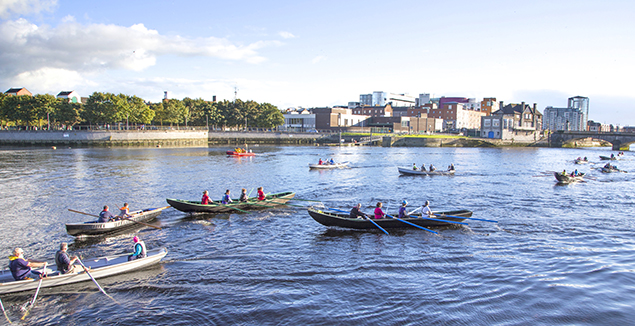 In the end it was Michael Grimes’ currach from Coonagh which won, and the fleet included a good selection of classic black currach types, with four of them here together with three grey Shannon gandelows. Photo: Gary MacMahon
In the end it was Michael Grimes’ currach from Coonagh which won, and the fleet included a good selection of classic black currach types, with four of them here together with three grey Shannon gandelows. Photo: Gary MacMahon



























